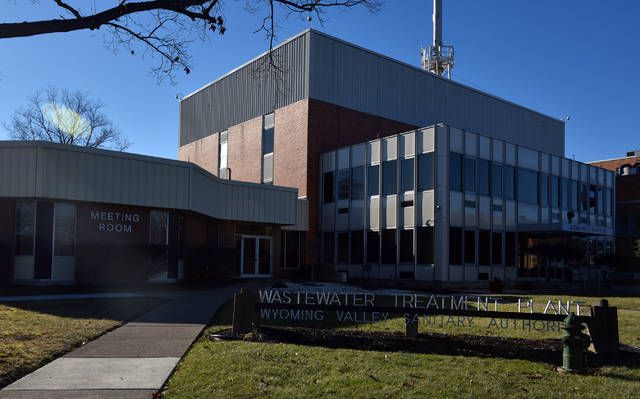Click here to subscribe today or Login.
What pollution reduction projects will be funded by the Wyoming Valley Sanitary Authority’s new stormwater fee?
It’s a question fee payers have been asking because much of the public discussion to date has focused on how the collected money will be used for street sweeping, mapping and cleaning out catch basins and storm drains.
A glimpse of the planned projects can be found in a 47-page report prepared by the authority’s consultant — Harrisburg-based Herbert, Rowland & Grubic Inc., or HRG — that has been posted at wvsa.org.
Filled with acronyms and charts, the plan was prepared in August 2017 and is still subject to alterations and a host of required permits and approvals.
But while it will be updated, it’s still an accurate general blueprint of the work the authority wants to complete to help participating municipalities comply with their mandate to reduce sediment, nitrogen and phosphorus washed into the Susquehanna River, and ultimately the Chesapeake Bay, over the next five years, said Donna Gillis, the authority’s public relations/regulatory liaison.
Approximately 65 “green” infrastructure projects are planned at an estimated cost of $16 million over the five-year period, the authority said in recent letters asking legislators to help find other outside funding and accelerate regulatory approval to reduce the burden on fee payers.
According to a review of the HRG plan:
Several stream restoration projects are planned because addressing “major erosion” along these waterways would hold back an estimated total 316,225 pounds of sediment annually.
The work would cover:
• 1,541 feet along Newport Creek in Newport Township
• Numerous sections along Warrior Creek in Wilkes-Barre and Hanover Township
• Six stretches of Spring Run in Hanover Township and Wilkes-Barre, including one with a blocked culvert
• 300 feet along Laurel Run in Plains Township
• 200 feet along an unnamed tributary in Duryea that leads to the Lackawanna and Susquehanna rivers
• 250 feet along Gardner’s Creek in Plains Township
• 20 feet along East Fork Harveys Creek in Jackson Township
Depending on the erosion severity and water flow at each site, the restoration may include the structural stabilization of stream banks and the installation of in-stream structures to redirect flow and/or absorb water energy.
More projects
The authority work also includes some “best management practices” projects, also known as BMPs, that municipalities already had suggested in their pollution reduction plans.
One is a riparian buffer restoration of 1,000 feet along East Fork Harveys Creek in the Back Mountain estimated to reduce sediment loss by 15,697 pounds per year.
This buffer would be a permanent 50-foot-wide area of trees and shrubs adjacent to the waterway to provide “both ecological and water quality benefits.”
The other plans, listed as BMPs 3, 4 and 5 in the report:
• Tree planting at Hilldale Park in Plains Township
• Restoration of 460 feet along Toby Creek
• Two rain gardens in Plains Township that would collect stormwater runoff and provide public education about environmental best practices
Rain gardens
As many as 25 rain gardens are planned to reduce sediment and pollutants, with locations to be determined, the plan says.
The two in Plains Township will contain excavated and shallow surface depressions planted with specially-selected native vegetation to treat and capture runoff. The deep-rooted plantings both filter and transpire runoff, it said.
Four larger “stormwater parks” also are planned in yet-to-be-identified locations, the plan says, describing such parks as both pollutant/sediment filters and recreation space that will improve quality of life.
The stormwater parks would be in locations with “significant space to work in” that hold runoff from a sizeable drainage area, with a benchmark that they should treat water coming from around 20 acres.
Some of the projects may require municipal cost sharing, possibly through grants.
Basin work
The largest proposed project would modify the giant Toby Creek detention basin in Pringle to make the water flow more meandering through plantings to screen out sediment and pollutants.
The fate of this proposal is unclear because the authority projects the work would prevent 3 million pounds of sediment from reaching local waterways annually, while the state Department of Environmental Protection (DEP) is only allowing credit for 400,000 pounds of sediment reduction, the authority said in the letters asking legislators to intervene in the matter.
A lower allowance would force the authority to construct additional infrastructure to meet the required reduction total, the authority said. In addition to DEP approval, the authority also faces the hurdles of obtaining clearance from the U.S. Army Corps of Engineers and the county Flood Protection Authority, which owns the basin as part of the Wyoming Valley Levee system.
Though not included in the roster, the authority also is working with the state Department of Transportation on possible joint projects that would allow both to receive some pollution reduction credits toward mandate requirements, HRG said. To proceed, the authority may be required to help fund the work or agree to perform long-term operation and maintenance.
Not off the hook
Once implemented, pollution reduction projects would be operated and maintained by the authority to ensure they continue to produce expected results, the plan said, noting all such upkeep must be documented in annual reports.
For example, the Toby basin project maintenance schedule could require the authority to mow the basin 10 times per year, perform weeding and invasive species removal annually, conduct inspections monthly and after large storms and remove sediment as needed.
Thirty-two municipalities signed up to participate in the regional stormwater plan managed by the authority, which imposed the fee to cover expenses. Although Warrior Run obtained a state exemption, the authority said the count of participating municipalities is still 32 because it had not included Warrior Run in its tally, anticipating its possible removal.
Residential fee bills are due March 15, and the authority has not yet announced when it will mail bills to commercial property owners.





